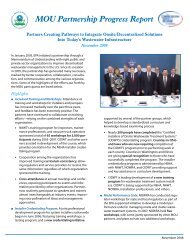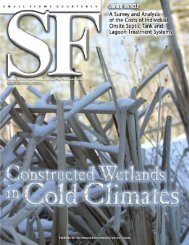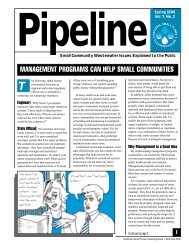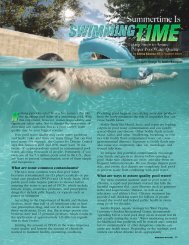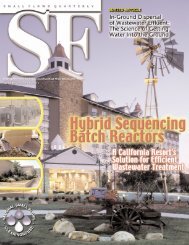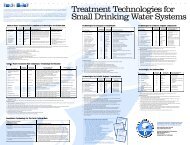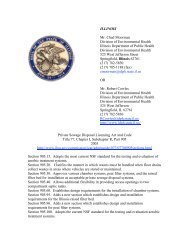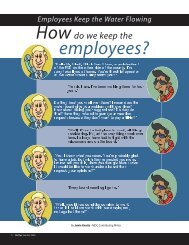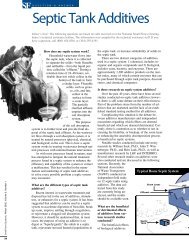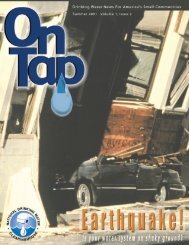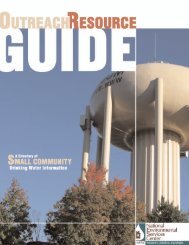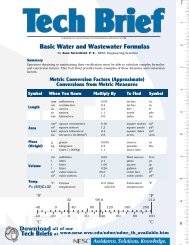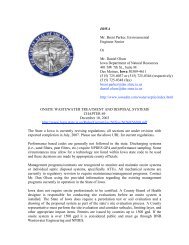Craig Mains | Technical Assistant - National Environmental Services ...
Craig Mains | Technical Assistant - National Environmental Services ...
Craig Mains | Technical Assistant - National Environmental Services ...
Create successful ePaper yourself
Turn your PDF publications into a flip-book with our unique Google optimized e-Paper software.
• Sluggish drains and toilets in the home<br />
• Odor of sewage in the house and/or outside<br />
Signs that drainfield failure has occurred:<br />
• Sewage backing up into the home<br />
• Ponding in the yard above or near the drainfield<br />
• Soil sinking or collapsing over any part of the system<br />
• excessive rainfall;<br />
• downspouts, gutters, basement sump pump<br />
drains and other rainwater or surface water<br />
drainage systems that divert water over the<br />
drainfield;<br />
• tree roots that interfere with the drainlines;<br />
• vehicles driving over the drainfield and<br />
cracking the pipes, and<br />
• age of the system.<br />
How can I tell if my drainfield<br />
is failing?<br />
The most obvious sign of drainfield failure<br />
is surfacing effluent. If the soil can no longer<br />
absorb the effluent, it will either rise to the<br />
ground surface and pool or, if the drainfield<br />
isn’t flat, it will ‘blow out’ the end of the last<br />
trench. You might also notice muddy soil<br />
around your septic system or in your basement,<br />
toilet or sink back-ups when you flush or<br />
do laundry, or strips of bright green grass<br />
growing over the drainfield.<br />
Can I drive on, pave over, or build a<br />
structure on my drainfield?<br />
N o. These activities can cause the soil to<br />
compact, exposing system components and<br />
p o s s i bly untreated sewage to the ground surfa<br />
c e. Paving over all or a portion of a dra i n f i e l d<br />
m ay prevent air from getting into the soil, impairing<br />
the treatment process, as well as limiting access<br />
for repairs, maintenance, or inspection.<br />
What can be planted over or near a<br />
drainfield?<br />
The best covering for your drainfield is<br />
grass because it helps to remove water and<br />
nutrients from the soil and helps to prevent soil<br />
erosion.<br />
Some people may choose to landscape<br />
their drainfield because of limited space or because<br />
they think it is an eyesore. The challenge<br />
is to find plants that will meet your landscaping<br />
needs but not clog the drain pipes.<br />
Thurston County, Washington, offers the following<br />
planting tips:<br />
- The deep roots of some vegetables may<br />
damage the drainfield pipes as can digging<br />
and rototilling the soil to prepare it for planting<br />
vegetables. Hand cultivate only.<br />
- Parts of the system may be only six inches<br />
under the surface. Adding two to three inches<br />
of topsoil to the drainfield should be fine<br />
but more than that could prohibit the exchange<br />
of<br />
air and<br />
water,<br />
decreasing<br />
the<br />
drainfield’s<br />
ability to<br />
treat the<br />
wastewater.<br />
- Plants<br />
should be<br />
low in maintenance<br />
and<br />
water needs and<br />
should be shallow rooted.<br />
29




